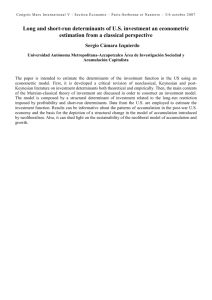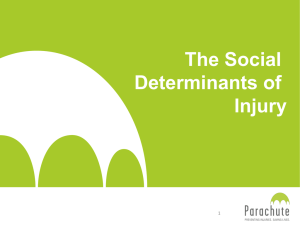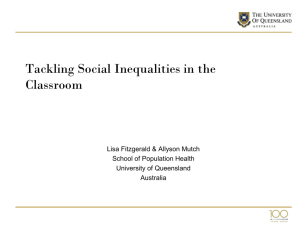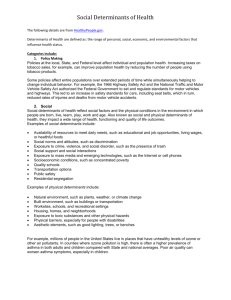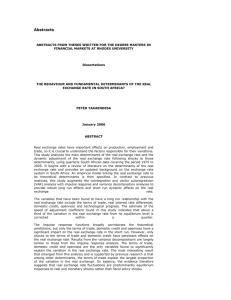presentation
advertisement
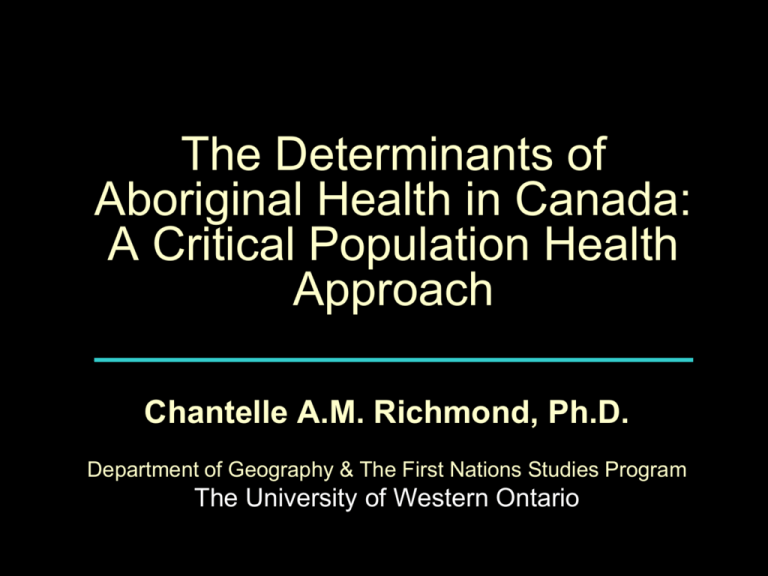
The Determinants of Aboriginal Health in Canada: A Critical Population Health Approach Chantelle A.M. Richmond, Ph.D. Department of Geography & The First Nations Studies Program The University of Western Ontario Introduction to the research Aboriginal health has become a priority among Canadian health researchers1,2 Focus on quantifying rates of disease and mortality Less attention paid to the processes underlying them These observations have not transformed into common understanding of the underlying causes of inequality E.g. Environmental dispossession 1. Adelson, 2005; 2. Reading and Nowgesic, 2002 2 Environmental Dispossession The processes through which Aboriginal people’s access to the resources of their traditional territories is reduced Directly – Physical displacement of communities Indirectly – Assimilationist policy Identities and cultures of Aboriginal peoples are intimately bound to the quality of their local environments Health and social effects of environmental dispossession are negative 3 Objectives of today’s talk 1. To conceptualize the determinants of health in rural and remote First Nation and Inuit communities 2. To examine how the process of environmental dispossession undermines the quality of health determinants 4 A narrative approach Aboriginal Community Health Representatives Invited to NIICHRO’s AGM May 2005 26 telephone interviews with CHR’s (June – August 2005) Rural and remote Inuit and First Nations communities from across Canada 5 CHR’s identified 6 health determinants 1. 2. 3. 4. 5. 6. Balance Life control Education Material resources Social resources Environmental/ Cultural connections • Income and Social Status • Social Support Networks • Education • Employment and Working Conditions • Social Environments • Physical Environment • Personal Health Practices & Coping Skills • Culture • Healthy Child Development • Gender • Health Services • Biology and Genetic Endowment 6 Environment/ Cultural connections “In my community, we are more northern and we have traditional foods that we depend on. We travel on the land, we socialize more together on the land, and we know each other, and that is good. We always go on word of mouth, if somebody is going through this or that, and this means everybody gets involved. We are lucky to have that because I know more southern communities are losing that [connectedness] and its affecting them and their health” (Debbie). 7 Environmental/cultural connections CHR’s described reduced access to environmental resources and shifting culture (i.e., environmental dispossession) as a source of serious decline in the quality of these health determinants This process is leading to: Life imbalance, loss of life control, changing forms of education, lacking material resources, and social dysfunction 8 Life Imbalance “For a long time my community didn’t have access to a lot of services, because the closest town is about 80 kilometers away. We were very self-reliant. More recently, as we are relying on cars and outside resources, the community has gotten away from things like gardening or cutting wood, and all those other healthier lifestyle practices that they used to do a long time ago, that kept them active and physically in shape (Michelle).” 9 Loss of Life Control “I think there is a lack of, a sense of um, self esteem in people. A lot of times you see it from residential school, like the impacts, and the lack of parenting skills, and the addictions, and stuff like that, that have resulted from that traumatic experience and it seems people are not sure how to move on (Meghan).” 10 Changing Forms of Education “No, the kids are not very active. Because they always want to play those Nintendo games, and all those computer games. And eating junk food. Sitting inside your house I guess, and the kids are always playing because the school year is over right. So they are just sitting inside (Nicole).” 11 Lacking Material Resources “The main employer is the band, and there are only so many full time jobs. So the people in those families are financially secure, whereas other people have to rely on seasonal jobs for their families, and then if you have a larger family and you have a seasonal job, by the time you start paying off your bills it is time for a layoff again. It’s like a vicious cycle, and our community members really struggle with that (Michelle).” 12 Social Dysfunction “If you ask for help, people will usually come around. But its different than in the past. Money has become a factor in everything; its not too often you have somebody helping an elder out like just as a good deed, it will often be because the person is getting money, or because one of the band programs is paying that person to help the elderly (Holly).” 13 Key Findings Balance, life control, education, material resources, social resources, environmental/cultural connections are key determinants of health Environmental dispossession, and its indirect and direct affects, is significantly compromising the quality of these health determinants 14 Key Findings No mention of certain health determinants from the Canadian list (e.g., child development, gender, health services, biology/genetic endowment) Is it possible that the CHR’s stories relate to a more basic notion about health need in the First Nation and Inuit context, Emphasis on the social determinants of health 15 What does this mean for research and policy? 1. Continued support for research into the social determinants of Aboriginal health is essential 2. A need for critical approaches that look for the ‘causes of the causes’ of inequality Seek to describe and understand what creates disparities in health Aboriginal health and social policy must take into account the social context of places 3. Study post-colonial influences on health at local level and make them central to research/ policy questions 16 Acknowledgements NIICHRO Dr. Nancy Ross Dr. Kue Young SSHRC Doctoral Fellowship CIHR Global Health Fellowship QUESTIONS? chantelle.richmond@uwo.ca 17
